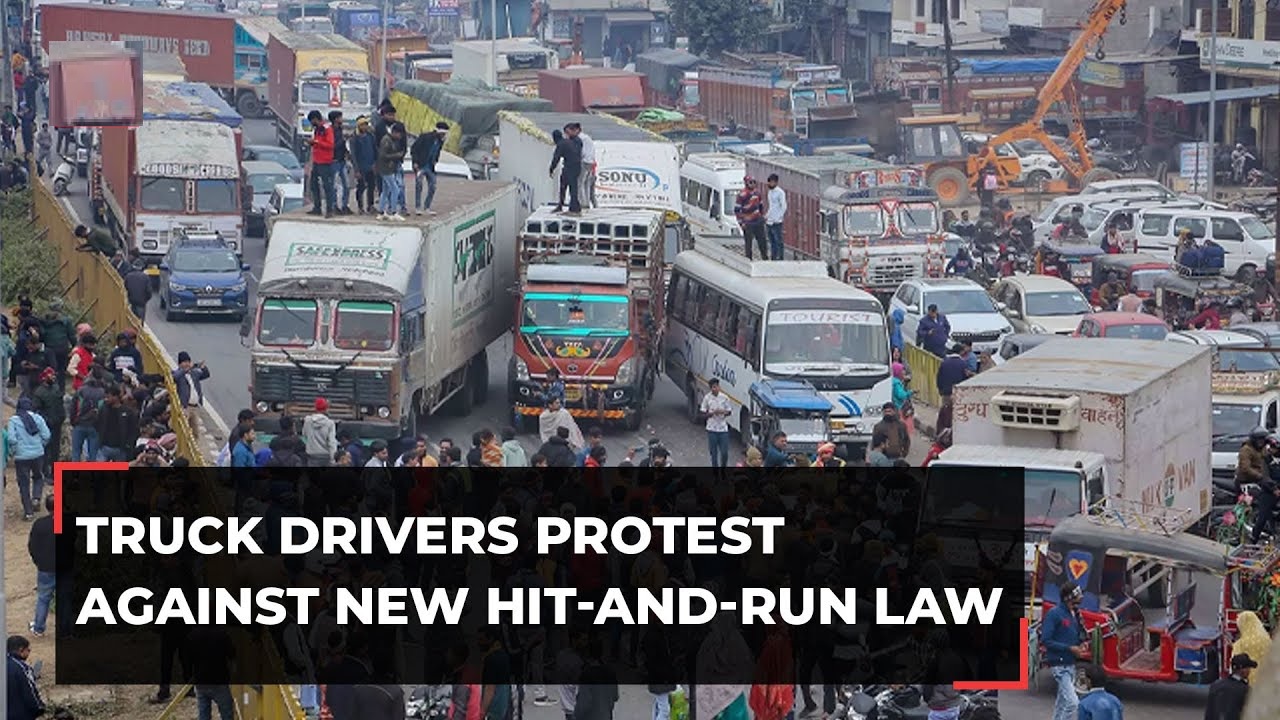The recent nationwide truck drivers’ strike, specifically in response to the enforcement of the Bharatiya Nyaya Sanhita (BNS), has spurred protests across several states, including Bihar, Punjab, Maharashtra, Madhya Pradesh, Himachal Pradesh, and Chhattisgarh. This strike has notably impacted fuel stations and the movement of essential supplies across regions.
Fuel Stations and Hit-and-Run Law
The strike has caused significant disruptions at Truck Drivers’ Strike Day 2 Fuel Stations BNS Bharatiya Nyaya Sanhita Hit And Run, with reports of long queues and panic among consumers. Concerns about the supply chain have heightened, leading to uncertainties about the availability of crucial resources.
Impact on Dispatching LPG Cylinders
Officials have flagged concerns about the strike’s effect on dispatching LPG cylinders to the market, raising alarms about potential shortages.
Protests and Road Blockades
The demonstrations have escalated to road blockades, as seen in the Nationwide Truckers’ Strike Day 2 reports, affecting highways and causing disruptions in various states.
Temporary Restrictions at Fuel Pumps
Chandigarh has taken measures like temporary restrictions on the sale of petrol and diesel amidst the ongoing strike, highlighting the severity of the situation.
Challenges Faced by Drivers and Passengers
The strike has led to long queues and panic buying at petrol pumps, as evidenced in reports from Mumbai and Nagpur, impacting both drivers and commuters.
Disruption in Vehicle Movement
States like MP have witnessed a significant impact on the movement of vehicles, leaving passengers stranded and fuel pumps crowded.
Key Concerns and the Way Forward
The striking truck drivers, supported by transporters’ bodies, oppose certain provisions in the new penal law, raising questions about its clarity and implications.
Addressing Emergency Situations
Amidst the chaos, concerns about unclear emergency responses have been raised, emphasizing the need for clarity and proactive measures.
- Nationwide Truck Drivers’ Strike: Truck drivers across India have entered the second day of their nationwide strike, causing disruptions in the supply chain and creating panic in fuel stations.
- Fuel Shortages and Panic Buying: The strike has led to fuel shortages, triggering panic buying among consumers. Long queues have been observed at petrol stations, with concerns rising about potential fuel price hikes and supply chain disruptions.
- Key Demands of Truck Drivers: The truck drivers are protesting against various issues, including fuel price hikes, increased toll charges, and demands for better working conditions. The strike has garnered support from various trucking associations and unions.
- Impact on Supply Chain: The ongoing strike is having a ripple effect on the supply chain, affecting the transportation of goods and commodities across the country. Industries reliant on timely transportation are experiencing delays and disruptions in their operations.
- Government Response: The government has initiated talks with representatives of the trucking industry to address their concerns. Negotiations are underway to find a resolution and alleviate the impact on essential services and goods delivery.
- Public Appeals for Restraint: Authorities have appealed to the public to avoid panic buying and assured that efforts are being made to resolve the issues raised by the truck drivers. The public is urged to remain patient and not contribute to unnecessary stockpiling.
- Transport Sector Challenges: The strike highlights broader challenges within the transport sector, including issues related to fuel pricing policies, toll charges, and the overall working conditions of truck drivers. Addressing these concerns is crucial for the long-term stability of the industry.
- Monitoring and Updates: Authorities are closely monitoring the situation, and updates are being provided regularly to keep the public informed. Citizens are advised to stay updated on the latest developments through official channels.
- Potential Economic Impact: The strike, if prolonged, could have significant economic ramifications, affecting various sectors that rely on the timely transportation of goods. Industries such as manufacturing, agriculture, and retail may face challenges in maintaining normal operations.
- Resolution Efforts: Efforts are underway to find an amicable solution to the demands raised by the truck drivers. The government is working towards a resolution to ensure the resumption of normalcy in the transportation and logistics sector.
As the truck drivers’ strike continues into its second day, stakeholders are closely watching developments, hoping for a prompt resolution to mitigate the impact on the economy and daily life.
FAQ
Q: What caused the truck drivers’ strike?
A: The strike is primarily in response to the enforcement of the Bharatiya Nyaya Sanhita (BNS) and its punitive measures for hit-and-run incidents.
Q: How are fuel stations affected?
A: Fuel stations are experiencing disruptions in operations, leading to long queues, panic buying, and concerns about the availability of petrol and diesel.
Q: Which areas are most affected by the strike?
A: States like Bihar, Punjab, Maharashtra, MP, HP, and Chhattisgarh are witnessing significant protests and disruptions due to the strike.
Meta Description
Explore the impact of the nationwide truck drivers’ strike on fuel stations, the enforcement of Bharatiya Nyaya Sanhita, and the challenges faced by drivers and consumers. Understand the protests, disruptions, and concerns amidst this ongoing crisis.





